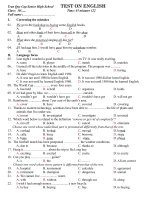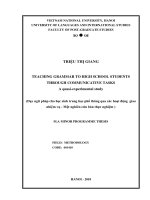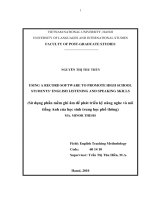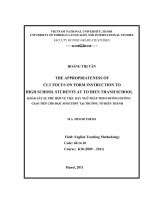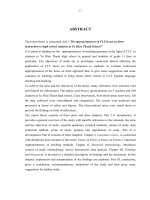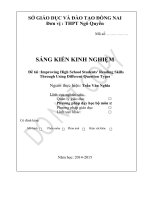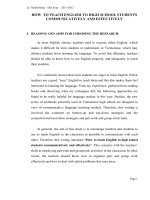Improving high school students doing english tests about language functions
Bạn đang xem bản rút gọn của tài liệu. Xem và tải ngay bản đầy đủ của tài liệu tại đây (136.08 KB, 25 trang )
A. INTRODUCTION
1. Rationale of the study
Nobody can deny the importance of English in our lives now. English is
introduced to the educational curriculum from primary education to tertiary
education. It is taught at schools, outside schools whenever by not only teachers but
also people who never go to any colleges of education. Working as a teacher, I must
constantly improve methods of teaching English. However, the renewal of teaching
and learning methods must meet the objectives, requirements of the curriculum and
how to apply on communication. Communication depends on many factors in the
process of learning a foreign language such as the practice of listening and
speaking skills, using correct grammar patterns, correct pronunciation and
intonation, right accent, etc. Because of that, learners need to master the above
factors so as to communicate more effectively.
When we talk about language functions, we are talking about the reason why
we use a language. Basically, the function of language is used for communication;
we use the language to give and receive messages between ourselves. We can break
this down into language functions. When we communicate with language, we can:
compare and contrast, make a complaint, express love or anger, persuade someone,
give advice, ask for something, ask for something politely, hide the truth (lie),
warn, give information, explain a process, blame something , avoid saying anything
and so on. Each language function can be associated with certain grammatical
forms. For example, we often use modal verbs in a polite situation,
- Might I borrow your pen?
- Please, could you give me your pen?
- Give me your pen!
You never say to somebody: Give me!
“Language functions and responds” plays an important role in learning
English. It not only helps students to use English naturally but also helps them
achieve good results in exams. It appears more and more in 15- minute tests, 45minute tests, final tests, graduation exams, entrance exams. Students will have
difficulty doing exercises about it unless they are well taught.
In university exams in recent years there have had a separated part about
cultural communication. These questions equal the number of questions about
word- stress or some other major grammars in English. Besides, as we all know
that the cultural diversity of each country is expressed differently through language.
If we do not learn to speak English when communicating we tend to use the
Vietnamese culture to convey the meaning of words. For my students in real
communication, they say either "Yes" or "No", but may not know how to answer
such other implications. There are many causes of this situation such as: they
1
haven’t concentrated on their learning attentively. Or they don’t know how to use
language naturally as well as do it correctly in assignments, tests, exams. Besides, I
think they have not had enough experiences, or methods of doing this type of
exercise. From these reality and importance, I came to a decision to give some
experiences to better this kind of exercise. That is the reason why I chose the topic"
Improving high school students' doing English tests about language functions",
which is my research.
2. Aims of the study
The research is aimed at:
- Contributing my a few experiences for teaching “Language functions and
responds” at high school.
- Sharing my own initiative experiences for colleagues so that they can use them as
references to help students prepare best for their exams.
3. Scope of the study
The study has been conducted on the students at Tinh Gia 1 high school in
the school year 2018-2019
4. Research methods of the study
- Based on teaching process
- Based on a number of references on communication functions in English.
- Based on some comments of my colleagues
2
B. DEVELOPMENT
1. THEORETICAL BACKGROUND
To have detailed knowledge about the communication culture of a language
in general and English language in particular, learners have to regularly
communicate with friends, teachers, native speakers. In addition, students should
be equipped with some basic knowledge about the communication. They need to
have vocabularies about every field, basic grammar structures. The learners, whose
first language is Vietnamese, use language with oriental culture. However, English
speakers use their language with western culture. Therefore, there are many
differences. In some situations, students may also translate into Vietnamese answer
to choose the correct answer. Additionally, they should apply the understanding of
English culture. In sum, mastering this aspect of language requires learners as well
as teachers to try their best during learning time.
2. PRACTICAL BACKGROUND
Students at Tinh Gia 1 High School come mainly from rural areas .They have
little received help or encouragement from parents or siblings because of their
unawareness of its importance. This affects their perception of the importance of
the English subject. All the things they focus on are the grammar section. When
they have to do “Language functions and responds” at tests, they will translate
them into Vietnamese to choose their answers or apply structures that they have
studied to solve these exercises. When communicating, the students do not take
advantage of their knowledge at the speaking section in the textbooks
One reason why I focused on this topic is that communicative English plays
an important part in our lives. Many students pride their selves on their wide
vocabulary and good understanding of English grammar. However, when they
communicate with native speakers, they have still difficulty in expressing their
ideas. Or they do not understand what speakers mean. When they are examined in
oral tests or written ones, the students will surely feel worried about it.
For example: (easy level)
- A: How do you go to school?
- B: ........................
A. By bike
B. Every day except Sundays C. I’m fine D. At 6.00 pm
They choose it very quickly. "A" is a correct answer
But with a more difficult question:
- A: “Do you mind if I smoke?”. B: “………….”
A. Yes, I don’t mind
B. No, I don’t think so
C. Yes, go ahead
D. No, go ahead
They probably choose A or even C. In fact, this is a question of permission
with structure "Do you mind ...."or "would you mind" and the answer tends to
negative respond. The answer is D.
3
And this is the result of this part in oral exams between teachers and students
at 15- minute tests, 45 minute-tests in the early of September in 2018 at class
10A10.
Oral test (the maximum score for this part is 5 points)
No
Full name
points
1
Nguyễn Hùng Cường
1
2
Lê Thị Lan
0
3
Huỳnh Thị Diễm Quỳnh
1
4
Lê hải Vân
0
5
Đỗ Quang Phúc
0
6
Trần thị Quỳnh Anh
2
In the 15-minute test: including 2 questions about communication. The maximum
score for this part is 1 point. Here are the total score of every student
15-minute tests
No
Full name
points
1
Nguyễn Hùng Cường
0,5
2
Lê Thị Lan
0,5
3
Huỳnh Thị Diễm Quỳnh
1
4
Lê hải Vân
0,5
5
Đỗ Quang Phúc
0
6
Trần thị Quỳnh Anh
0
There are 3 questions in the 45- minute test. The maximum score for this part is
0.75 points. Here is the total score of every student
45-minute test
No
Full name
points
1
Nguyễn Hùng Cường
0,25
2
Lê Thị Lan
0
3
Huỳnh Thị Diễm Quỳnh
0,5
4
Lê hải Vân
0
5
Đỗ Quang Phúc
0
6
Trần thị Quỳnh Anh
0,5
…
From the results above, they really worry me. I started paying much attention
to my teaching method about this part. Firstly, I make them practice speaking as
much as possible during speaking lessons. Secondly, I give more assignments that
they must do not only at school but also at home. These tasks will be carefully
checked in the following day. Additionally, I encourage them to improve their
listening skills, which can help them master this kind of exercises. Besides, there
have always been some questions in the test, which makes them not ignore this
4
kind of exercises. Furthermore, I also seek documents related and classify them
into many kinds. Some are applied for starters, other things are for better students. I
especially concentrate on the students, who are going to take college entrance
exams.
I demonstrate extracted parts from graduation and university exams. I always
emphasize that they usually appear in these exams. Of course, I also give some
experiences when copying with them.
3. CONTENTS
3.1 Definition
"Functional language" is language that we use to perform various "functions" such
as giving advice or apologizing. Functional language typically uses fixed
expressions for each function–for example "if I were you" or "my suggestion is" in
giving advice, and "it was my fault" or "please forgive me" in apologizing.
3.2 Some examples of language functions and special notes
1. Apologizing
To apologize to anyone I may say the To accept the apology one might say
following ways
following ways
Forgive me. I’m terribly/ awfully
sorry about …..
Please accept my apologies for
…..
I’d like to apologize for …..
I’m sorry I didn’t mean to ….
Oh no! Did I do that? I’m sorry.
I’m (really/so) sorry.
Sorry about that.
I (really) must apologize
I didn‘t mean that. Please accept
my apology
It‘s totally my fault
I accept (full) responsibility for
my actions
There is no excuse for my actions
I can see how you might be
annoyed …
I don't know what got into me
I think I went a bit too far
Please don't hold a grudge
All right/ That’s quite all right.
I understand completely
You really don’t have to apologize
for …..
You don’t need to apologize for
…..
Oh, that’s alright. It can happen to
anyone.
It’s not your fault.
Don’t worry about it.
It’s OK/ That’s OK/alright
No problem.
Forget it.
No need to apologize:
Never mind
It doesn’t matter
No harm done
Please don’t blame yourself
I forgive you
Your apology is accepted
5
If I could turn back the clock,...
Please let me know if there is
anything I can do to compensate
for it.
Example
A: "I'm sorry about that!". B: "- ................!"
A. No harm done
B. Of course
C.You're welcome D. It's Ok
The answer is A
Note: we should choose acceptable responds rather than unacceptable ones.
2. Complimenting:
To compliment anyone we can say the In response to a compliment you can
following ways or structures:
use one of the following statements:
I think your hair is very nice.
Thanks / Thank you / Thank you.
I really love / like your hair. It'so
It's nice of you to say so.
beautiful.
Thanks. Yours is even nicer.
What beautiful hair you have!
Thanks. Yours is nice too
You really have a / an Adj + N
Thanks. I Had it cut yesterday.
How your house is gorgeous!
Thanks. That's a nice compliment
This soup is so delicious. My
How nice of you to say so.
Compliments to you!
I'm glad you like it.
You look very good in this dress!
Yeah, it's my favorite, too.
It
was
nothing
really.
(Demonstrating the modesty of the
speaker)
You've got to be kidding!
You did a good job! Good job!
For these ones, you may use thanking
What you did was wonderful/ words
desirable/ amazing.
You played the game so well.
Note: When replying to a compliment we often use thanks (as well as responds to
our invitations or offers) and you may add some polite words
Example:
1. Laure: "What a lovely house you have!"
Maria: "_______."
A. No problem
B. Thank you. Hope you will drop in
6
C. I think so
D. Of course not, it's not costly
2. A: "Wow! What a nice coat you are wearing!" B: "______"
A. Certainly. Do you like it, too?
B. I like you to say that.
C. Yes, of course. It's expensive. D. Thanks. My mother bought it for me!
(The answers are italicized)
3. Thanking
To say thanks to someone:
to reply
Thanks a lot / Thanks / Thank
My pleasure / It was my pleasure
you.
No problem.
I cannot thank you enough for
You're welcome.
your help.
Not at all.
It's very kind of you to .... Thank
I'm glad you like it
you.
Do not mention it.
That was nice kind / sweet / good
Do not worry about it.
of you. Thank you.
Forget it.
I am grateful to you for......
That's OK
That's alright
Never mind!
That's alright
Think nothing of it
It was the least I could do
Example
1. A: “I can’t thank you enough for your help.” B: “………….”
A. I’d rather not
B. My pleasure
C. I don’t mind
D. My goodness
2. A: “Thank you for your help.” B:“………….”
A. With all my heart
B. It’s my pleasure C. Never mind
D. It is for you
3. A: “Thank you for the nice gift.” B: “………….”
A. But do you know how much it costs
B. You’re welcomed
C. You’re welcome
D. My goodness
4. Anne: “Thanks for the nice gift!”
John: “............”
A. In fact, I myself don’t like it.
B. You’re welcomed.
C. I’m glad you like it.
D. But do you know how much it
costs?
(The answers are italicized)
Note: in this section the student can be confused with the answer "you are
welcomed" instead of "You are welcome"
4. Some other common things
Ask about health, work or family
7
ask
How are you?
How've you been?
How are things?
How's everything?
How are you doing?
How is it going?
What's happening?
What's new?
What's going on?
A: I'm so depressed. I think I'll
quit my job soon.
My friend is hopeless.
answer
I'm fine, thank you, and you?
Fine, thanks, and you?
Very well, thank you, and you
Great
All right
OK
Not too bad
Too bad
so so
Not much.
Nothing
B.Take it easy. Everything will be
fine.
Do not worry. It's not that bad.
Example
1. “How are you doing?”. “…………….”
A. Great. Thanks B. Yes, I am C. I’m reading a novel D. I’m afraid not
2. “………….”. “Nothing”
A. What do you do? B. How are you? C. Are you a new comer? D. What’s new?
3. “ Hi, Tom. How’s everything?”
A. Not bad. How are you?
B. Hi, How do you do?
C. No, thanks
D. Hi
4. Lan: Make yourself at home.
Peter: ............... ..
A. Not at all. Do not mention it.
B. Thanks. Same to you.
C. That's very nice. Thank you.
D. Yes, Can I help you?
( The answers are italicized)
Note: In this section the students may confuse the questions, which leads to
choosing incorrect responds.
5, Greeting and introduction:
When being introduced, we often use:
responds
I'd like you to meet John.
I'd like to introduce John.
8
This is John. In return we use:
How do you do?
Glad to meet you
Nice to meet you
Pleased to meet you.
To introduce myself, we often use:
Hello / Hi, I'm Mary.
Hello / Hi, My name is Mary.
Reply:
Hello / Hi, I'm Russian.
Hello / Hi, my name is Nga
Hello / Hi Lan
Good morning
Nice / Glad to meet you. Paul
How do you do?
responds
I do not think we've met. I'm Mary.
How do you so. I'm Mai.
Nice to meet you. I'm Mai. (My
name is Lan)
Pleased to meet you. I'm Mai. (My
name is Lan)
Hello / Hi Tom
Good morning
Nice / Glad to meet you too, Russia.
Example
1. Peter: “Hi, Jane”. Jane: “……………..”.
A. How are you? B. Hi, too
C. Ok, See you soon
D. Hi. I’m Nga
2.John: “………………”. “ How do you do. I’m Mary”.
A. Have they met before?
B. How are things?
C. What’s your name?
D. Hello. I’m Lan
(The answers are italicized)
6. Saying goodbye:
Some saying goodbye and some responds
A:Well, I’m afraid I have to be going./I really must go now.B: Thanks for coming.
A: It was nice to see you.
B: Same here.
A:Great seeing you.
B: Same here.
A: I’ve really got to go.
B: OK. See you/See you again.
A: Bye! Lan
B: Bye! Have a good day.
A: Bye! Mary
B: See you later.
A: See you later.
B: Bye! Tim
A: Bye! Have a nice weekend. B: Thanks. You too.
A: Take care! Have a nice trip. B: Thanks. Bye!
A: Well, it’s getting later.
B: Maybe we can talk again.
A: Until next time.
B: Goodbye.
A: See you later.
B: So long. Take care.
A: See you tomorrow.
B: Goodbye.
Example
9
1. “But it’s very late, so ……….”
A. take care
B. have a good day
C. goodbye for now
D. it’s great fun, thanks.
2. “Oh no, I’m late for my appointment. ……….”
A. Catch you now
B. Catch you later
C. Nice to see you again
D. pleased to see you.
3. A. “………………………….” - B. “Thanks, I will write to you when I come to
London.”
A. God bless you!
B. Better luck next time!
C. Have a nice trip!
D. Have a go!
(The answers are italicized)
7. Warning:
Note: The negative warning is replied by negative words.
A: Do not push hard against hothouse toy, or you might, break it.
B: No, I will not / Thanks. I will not.
The affirmative warning is replied by affirmative words.
A: Watch out! Be careful!
B: OK. I will.
A: Work hard or you will fail the exam.
B: I will.
8. Invitation, suggestion:
Invite anyone to go anywhere / do anything, we can say the following ways:
Would you like to go to the movies with me tonight?
Are you free to go to the movies with me tonight?
Do you feel like/ fancy going to the movies with me tonight?
How about/ What about going to the movies tonight?
Let’s go to the movies tonight?
Why don’t we go to the movies tonight?
Shall we go to the movies tonight?
to reply we can use either an acceptance or a refusal
acceptance
refusal
Yes, I’d love/like to.
That’s sounds great!
That’s sounds like fun.
That’s a good idea!
That would be great/ wonderful.
Ok. Let’s do that.
Why not?
I’d love/like to, but…
That’s sounds great, but…
That’s sounds like fun, but…
Let’s not.
That’s a good idea, but…
That would be great/ wonderful,
but…
10
Some other time, perhaps
I wish I could
I’m afraid I can’t
Sorry, I can’t because ….. Sorry I
don’t particularly like
To offer to help someone we can use one of the following expressions:
Let me help you
How can I help you? How can I be of help?
Would you like some help? Do you need some help?
What if...? ( if I can...)
Would you like something to drink?
Let me make you a cup of tea! coffee!
Shall I cook something for you?
accepting
Yes, please!
Yes, could I have some orange juice.
Thanks, that would be a great help! That would be helpful!
As long as you don’t mind:
It would be nice/ great/ helpful/... if you could!
politely refusing
No, thanks:
No, don’t worry!:
No, that’s OK!
Thanks but I can manage!
Example
1. “Why don’t we go out for a walk?” “ ……………….”
A. Why not
B. Yes, please
C. Ok, let’s
D. Never mind
2: Alice: "What shall we do this evening?" - Carol: "______"
A. Let’s go out for dinner.
B. Oh, that’s good!
C. No problem.
D. I went out for dinner.
3. "Let's go to the movie now"
-"Oh! ............."
A. I don't
B. Why's that?
C. I need it
D. Good idea
(The answers are italicized)
Note:
If we use this structure:" Would you love / like to ....?" We should say:" Yes,
I'd love / like to" to accept, or "I'd love / like to but ..." to refuse. Some
students prefer using “Yes, I would”, which is not a natural respond in
English. Maybe they see: Would you…
9. Some other language functions
11
Giving Advice
I think/I really think you need
The best/most important thing
to…
(to do) is to ...
How about you do it ...?
A wise man once said ...
Why don't you consider ...?
It might be an old wives' tale,
You could (try) ...
but ...
Be fine were you
Requesting
Can I...?
Could you give me a hand
Could I possibly...?
with…?
Could you...?
Do you think you could…?
..., if it's not too much trouble.
Are you any good at…?
Are you good at ...?
I could use some help…
Giving bad news to someone
I regret to inform you that ...
Are you sure you want to hear
I'm sorry to say (that) ...
this?
Unfortunately, ...
At this moment in time, ...
I am sorry to have to tell you ....
Despite my best efforts, ...
I
apologize
for
any
It's out of my hands....
inconvenience caused.
Realistically, ...
I have some bad news for you
There's no easy/nice way to say
Do you want the good news or
this, ...
the bad news first?
There's good news and bad
I am sorry to have to inform
news.
you that ...
Giving good news and responds
A: I passed my exam! B: That's great! Congratulations! Or:
Oh, that's good! I'm glad to hear
I'm proud of you!
that.
You deserve it!
Good Way
Good for you!
You've done a good job!
Giving bad news and responds (to encourage someone in trouble)
A: I failed my exam! B:
I’m sorry to hear that.
That's OK
I know this is too much to bear:
Everything Will Be Fine
I think I understand how you
Take it easy
feel:
It's going to be alright
You have just got to learn to
Do not give up!
accept it and move forward
Be strong!
Do not worry!
It's not that bad.
12
10. Asking permission
Would you mind ... /Do you mind.... This structure we often use negative
responses.
1. A: Would you mind if I turn on TV? / Would you mind turning on TV?
B: Not at all / No, of course not / No, go ahead
2. A: Would you mind if I smoke here?
B: No, Not at all / No, of course not / No, go ahead / No, please so/ No, go
ahead
In some special case, we can use affirmative responds
3. A: Would you mind if I open the window?
B: Yes, It is very cold now. (B minds and does not want A to open the
window)
4. A: May / Can / Could I smoke here?
B: No, you cannot. / No, of course not. / Yes, you can. / Yes, go ahead /
Yes, of course / Sure / Sure, go ahead / Certainly / I am afraid you cannot / I do not
think you can / No, not now.
5. A: Can / Could I Use Your Phone?
B: No, you cannot. / No, of course not. / Yes, you can. / Yes, go ahead /
Yes, of course / Yes, here you are / Use it! Do not ask.
6. A: Is it OK / alright if ...:
Do you think I can...:
Anybody Minds if...?
Used some responds above
Note: We shouldn't use "No, you could not" instead of" No, you cannot".
Generally people do not use "could" when replying the permission.
Exercise
1. "Do you mind if I smoke?". "............."
A. Yes, I do not mind
B. No, I do not think so
C. Yes, go ahead
D. No, go ahead
2. "Could I borrow your pen?". ".................. .."
A. No, you can use it
B. Of course, you can use it all day
C. Not at all you can use it all day
D. Yes, You would
3. "Could I borrow your calculator?". ".................. .."
A. Yes, You could
B. Yes, You can
C. Yes, You by
D. Yes, You will
4. "May I smoke?" "....................."
A. What suits you?
B. You are free
C. Accommodates yourself!
D. Go Ahead
(The answers are italicized)
11 Ordering and threatening
13
For example:
Leave Me Alone!
Give me money or I will kill you!
To reply those we can use either negative words or positive ones
I will / I will not
OK
Take it easy! (= Calm)
Will by: (= be making it)
Example
1: A: "Mum, I've got 600 points on the TOEFL test. B: " - "______"
A. Good Way!
B. Oh, hard luck
C. Yes, go ahead D. No, go ahead
2 A: "Our team has just won the last football match."
B: "______"
A. Good idea. Thanks for the news.
B. Yes. I guess it's very good.
C. Well, that's very surprising!
D. Yes, it's our pleasure.
3. A: "I've passed my driving test. B: " .........."
A. Do you?
B. Congratulations!
C. It's nice of you to say so.
D. That's a good idea.
4. A: "I'm taking my driving test tomorrow" B: ".............................. .."
A. Good luck!
B. Best wishes!
C. Good Way!
D. Congratulation!
5. A: "..................." "Was she really? I'm sorry to hear that. "
A. Mr. Bought a new house has Smith.
C. Mr. Smith wanted to have a new house.
B. Mr. Smith was shot dead yesterday.
D. Mr. Smith has passed his driving test.
6. A: "My book has been published ". B: "............... .."
A. Oh, thanks
B. I'm sorry to hear that.
C. That's great! Congratulations
D. Good luck!
7. A: "John and Mary are getting married next week. "B: "................"
A. Congratulations
B. Really? You're kidding!
C. Are they? I do not believe it
D. B or C
(The answers are italicized)
12. Attracting attention, interrupting, asking for directions.
Excuse me! / Hey, John / Waiter? / Sir? / Oh, Miss / Pardon. We can use one of the
following expressions to reply: Yes? / Yes? What can I do for you? / Can I help
you? / Yeah?
Example
1. "..................." "No, it's alright"
A. Lovely!
B. May I ask you a question?
C. Excuse me!
D. Am I interrupting?
14
2. "Oh, Miss?". "............"
A. That's all right
B. I'm sorry.
C. Yes?
D. Yes, I am
3. "Excuse me, Jim?". "............... .."
A. It's OK
B. No problem. C. Hey, Tom
D. Yeah?
(The answers are italicized)
Extracted from university exams
This kind of question in graduation and university tests gets more and more
difficult and complicated.
In 2016: code 168
Question 15: A waiter in a restaurant is talking to a customer who has just finished
his meal there. Select the most suitable response to complete the exchange. Waiter: “Here’s your bill, sir.” - Customer: “______”
A. Don’t mention it.
B. Can I pay by credit card?
C. What do you have?
D. You’re welcome.
Question 21: Two close friends Tom and Kyle are talking about Kyle’s upcoming
birthday. Select the most suitable response to complete the exchange.
- Tom: “Can I bring a friend to your birthday party?” - Kyle: “______”
A. It’s my honor.
B. Let’s do it then.
C. The more the merrier.
D. That’s right.
In 2017: code 424
Question 21. David and his teacher are meeting at the school gate.
David: "Good morning, Mr Deakin. How are you?" Mr Deakin: "
. And you?"
A. I'm going home
B. I'm fine. Thank you
C. I'm having a class now
D. I'm busy now
Question 22. Linda is thanking Daniel for his birthday present.
Linda: "Thanks for the book. I've been looking for it for months." Daniel: " ."
A. I like reading books
B. Thank you for looking for it
C. You can say that again
D. I'm glad you like it
In 2018: code 401
Question 1: Silas is talking to his roommate, Salah, about the Olympic Games.
- Silas: "Do you think our country can host the Olympic Games some day in the
future?"
- Salah: "______. We can't afford such a big event."
A. You can say that again
B. I can't agree with you more
C. Yes, you're right
D. No, I don't think so
Question 2: Laura is telling Bob about her exam results.
- Laura: "______"
- Bob: "That's great. Congratulations!"
A. I hope I'll pass the exam tomorrow.
B. I've passed the exam with an A.
15
C. I'll get the exam results tomorrow.
D. I didn't do well in the exam.
Extracted from exams for talented students (grade 12) in Thanh Hoa province
School year: 2014-2015
1. Nam: “ I'm having some friends over for lunch this Saturday. Would you like
to join us?”
Huong: “______________________”.
A. Can I take a rain check?
B. Come on. It's your turn.
C. Thanks, but I mustn't
D. As a matter of fact, I do.
2. Tom: “Wasn't it Mozart who composed Swan Lake?” Jane: “__________.”
A. Yes, he wasn't
B. It's out of question
C. I haven't a clue
D. It's not my favorite
School year: 2015-2016
9. - Daisy: “What a lovely house you have!” - Mary: “………….”
A. Lovely, I think so
B. No problem
C. Of course not, it’s not costly
D. Thank you. Hope you will drop in
School year: 2016-2017
21. ''You must have had a very good time on holiday."
"__________, it was a disaster. Everything went wrong."
A. By tradition
B. On the condition
C. In short
D. On the contrary
23. - John: “If only I hadn’t lent him all my money.”
- Peter: “________ ”
A. I’m afraid you will have to do it.
B. All right. You will be OK.
C. Sorry, I have no idea.
D. Well, you did, so it’s no use crying over spilt milk.
School year: 2017-2018
25.-“Do you mind if I take a seat?”
- “______________”
A. Yes, I don’t mind
B. No, do as you please
C. No I mind
D. Yes, do as you please
As can be seen. They are getting more and more complicated. By the way, I would
like to give some more advanced sentences and keys
1. "Would you please repeat it? Sorry that I ______________ it."
A. don’t so catch
B. couldn’t quite get
C can’t quite catch
D. didn’t quite understand
2. _ "Would you mind opening the door for me ?” _“ _________________ ”
A. Yes, I’ll do it now.
B. No, not at all.
C. I’d love to
D. Yes, I do.
16
3. Charles: “ Excuse me ….Mr. Ward?” – Mr. Ward: “____________?”
A. Eh! What
B. Yes
C. No
D. Thank you
4. “Sorry to interrupt. Do you have a minute? “ - “ … “
A. Thank you for your information.
B. Have a nice day ! See you later.
C. Can it wait?
D. The same to you.
5. -I reminded you not to forget the appointment. - ____________ ..
A. So you did
B. So I do not
C. So did you
D. So do I
So you did: đúng là bạn có nhắc khác với So did you: bạn cũng thế
6. A: It seems to me that spring is the most beautiful time of year.
B: ______. It really is lovely!
A. You're exactly right!
B. You could be right.
C. You're dead wrong.
D. I couldn't agree less
7. A: This grammar test is the hardest one we've ever had this semester!
B: ______ but I think it's quite easy.
A. I couldn't disagree more,
B. I understand what you're saying,
C. You're right,
D. I don't see it that way,
8. “Hello, may I speak to Mr. Washington, please?” - “______”
A. No, you may not
B. That's right
C. Hold on, please
D. You're welcome
9. "Give my best wishes to your parents." - "______."
A. It's my pleasure
B. You're welcome
C. Thanks, I will
D. Good idea, thanks
10.“How do you like your steak done?” - "______”
A. I don't like it very much.
B. Very little.
C. Well done.
D. Very much.
11."So long!" is another way of saying ______
A. Hello!
B. Cheer up!
C. I'm very happy.
D. Goodbye!
12."I'm so upset. Everyone seems to betray me." - "______"
A. Relax. It's not that bad.
B. Yeah. I think you can do it.
C. Oh, I'm sorry.
D. Don't apologize them.
13. "Do you think our basketballers played very well yesterday?"."________"
A.They were not nervous at all
B.They were still young
C.They played naturally
D.They couldn’t have done better
14.A: ______B: Roger, I'm coming to land now.
A. You are clear to land!
B. Who are you talking about landing?
C. Who does this piece of land belong to?D. Finally, you have asked Roger for
landing.
You are clear to land: đây là thuật ngữ hàng không: “sẵn sàng hạ cách”
17
15."The weather here in summer is so changeable. Please take an umbrella when
you go out." - "______"
A. Well, don't worry
B. Well, it just depends
C. Oh take it easy
D. Ok, just in case
16."Do you mind my smoking here?" - "______"
A. No, thanks
B. No, good idea
C. Yes, please
D. Yes. Better not
17.A: A motorbike knocked Ted down. B: ______
A. What is it now?
B. What a motorbike!
C. How terrific!
D. Poor Ted!
18.A: Could I speak to Susie please? B: Yes, ______.
A. answering
B. talking
C. saying
D. speaking
19.A: Here's your change. B: ______
A. Yes, please.
B. That's right.
C. Keep it as a tip. D. I've no idea.
20.A: ______.B: I'm in two minds.
A. Are you in favor of sex education? B. Would you mind stopping the
noise?
C. What's wrong with your mind?
D. When did it happen?
21.A: How's everything? B: ______.
A. Nothing interests me.
B. Let's call it a day!
C. So far so good!
D. Everyone knows it.
22."Could I borrow your calculator?" "______"
A. Yes, you could.
B. Yes, you can. C. Yes, you do.
D. Yes, you will.
23."When does this passport expire?" "______"
A. You can pick it up tomorrow.
B. It was very expensive.
C. It's good for one month.
D. I want to return to my hometown.
24."These sausages are delicious, aren't they?" "______"
A. They certainly are.
B. Yes, they taste salty.
C. I think so.
D. Yes, I'd love some.
25."Can I see your passport?" "______"
A. Sure. There you go.
B. No, I'm sorry.
C. Yes, I had one issued recently.
D. Oh, thanks.
Some experiences when choosing best responds
• Study the first sentence to understand what it means: request, complement,
invitation………
• Read 4 responds very carefully. Pay attention to pronoun, tense, meaning..
• When we have to choose one of two responds (both answers are
grammatically correct and they have the same meaning) students should
choose positive ones. For example: accepting an apology, accepting an
18
invitation, agreeing an idea....Besides they should look at tense, pronouns
carefully.
• paying attention to some incorrect words "you're welcome" not "you're
welcomed", "congratulations" not "congratulation"…etc
• Eliminate any definitely wrong answers and choose the best answer from the
remaining choices
4. RESULTS
After discovering the fact, I have quickly attached special importance to both
the method and knowledge source about this matter. Here are the results of the
students that I have talked about at the end of the second term.
The maximum score for this part is 5 points. Here are the total score of every
student
Oral test
No
Full name
points
1
Nguyễn Hùng Cường
4
2
Lê Thị Lan
4
3
Huỳnh Thị Diễm Quỳnh
5
4
Lê hải Vân
4
5
Đỗ Quang Phúc
5
6
Trần thị Quỳnh Anh
5
In the 15-minute test: including 2 questions about communication. The maximum
score for this part is 1 point. Here are the total score of every student
15- minute test
No
Full name
points
1
Nguyễn Hùng Cường
1
2
Lê Thị Lan
0,5
3
Huỳnh Thị Diễm Quỳnh
1
4
Lê hải Vân
0,5
5
Đỗ Quang Phúc
1
6
Trần thị Quỳnh Anh
1
There are 3 questions in the 45- minute test. The maximum score for this part is
0,75 points. Here are the total score of every student
45- minute test
No
Full name
points
1
Nguyễn Hùng Cường
0,75
2
Lê Thị Lan
0,5
3
Huỳnh Thị Diễm Quỳnh
0,75
4
Lê hải Vân
0,75
5
Đỗ Quang Phúc
0,75
19
C. CONCLUSIONS
When teaching about language functions, it is important that teachers
explicitly teach the vocabulary and phrases associated with each language function.
For example, when teaching the language function of compare/contrast teachers
may teach the following vocabulary: both, similar, also, different, in contrast,
similarly, etc. During the lesson planning and preparation stage, teachers should
brainstorm the vocabulary words associated with the language function that will be
taught. It is important that as students become familiar with the vocabulary
associated with each language function that more advanced functional vocabulary
is introduced to students.
In addition to functional vocabulary, students must also be introduced to
grammatical structures associated with each language function. For example, when
teaching the language function of compare/contrast, teachers might teach
comparative adjectives (i.e., smaller than, more expensive than, etc) or superlative
adjectives (i.e., smallest, most expensive).
English learners must be provided with ample opportunities to practice the
vocabulary and grammatical structures associated with language functions in both
oral and written contexts. When preparing for a lesson, teachers must identify how
the vocabulary or grammatical structure will be explicitly introduced to students, as
well as how students will practice in a structured way under the guidance of a
teacher. Functional vocabulary and grammatical structures can be differentiated for
students at varying proficiency levels, with students at the lower levels of English
proficiency practicing easier vocabulary and grammatical structures than students
at higher levels of English proficiency.
It is my hope that my own knowledge and experience will be suggestions for
improvements for those who are interested in studying English and "have to" pass
exams.
Obviously, mistakes are unavoidable, all comments and remarks on this
research will be high appreciated
Thank you very much!
20
LEADER'S CONFIRMATIONS
(XÁC NHẬN CỦA THỦ TRƯỞNG ĐƠN VỊ)
Thanh Hóa, ngày 10 tháng 5 năm 2019
I strongly ensure this is my own work
(Tôi xin cam đoan đây là SKKN của
mình viết, không sao chép nội dung của
người khác.)
Writer
Nguyễn Thúy Phượng
21
1.
2.
3.
4.
5.
6.
7.
REFERENCES
Phương pháp làm bài và bài tập trắc nghiệm Tiếng Anh- Chức năng giao tiếp
Câu đáp lại. Tác giả: Nguyễn Bảo Trang. NXB Đại học quốc gia Hà Nội.
English Today (bộ đĩa học tiếng Anh giao tiếp)
Giao tiếp tiếng Anh thông dụng- Tác giả Thanh Hà. NXB Từ điển bách khoa.
Học nhanh tiếng Anh giao tiếp- Tác giả Thanh Hà. NXB Hồng đức
10000 câu đàm thoại tiếng Anh dành cho giao tiếp- Tác giả Thanh Mai. NXB
Dân trí
Cẩm nang tiếng Anh giao tiếp trong mọi tình huống- Tác giả Lê Văn Sự.
NXB Hồng Đức
Agar, M (2001). Language Shock: Understanding the Culture of
Conversation. New York
22
SỞ GIÁO DỤC VÀ ĐÀO TẠO THANH HÓA
TRƯỜNG THPT TĨNH GIA 1
SÁNG KIẾN KINH NGHIỆM
IMPROVING HIGH SCHOOL STUDENTS' DOING ENGLISH TESTS
ABOUT LANGUAGE FUNCTIONS
(NÂNG CAO KHẢ NĂNG LÀM BÀI TẬP PHẦN CHỨC NĂNG
GIAO TIẾP CHO HỌC SINH THPT)
Người thực hiện: Nguyễn Thúy Phượng
Chức vụ:
Giáo Viên
SKKN môn:
Tiếng Anh
THANH HÓA, NĂM 2019
23
CONTENTS
A. INTRODUCTION
1. Rationale of the study......................................................................................1
2. Aims of the study.............................................................................................2
3. Scope of the study............................................................................................2
4. Research methods of the study........................................................................2
B. DEVELOPMENT
1. Theoretical background........................................................................... 2
2. Practical background............................................................................... 2
3. Contents....................................................................................................4
3.1 Definitions.......................................................................................... 4
3.2 Some examples of language functions and special notes.....................4
3.3 Extracted from university exams and other exams..............................16
3.4 Practice and keys...............................................................................17
4. Results......................................................................................................20
C. CONCLUTIONS..........................................................................................20
REFERENCES
24
25
